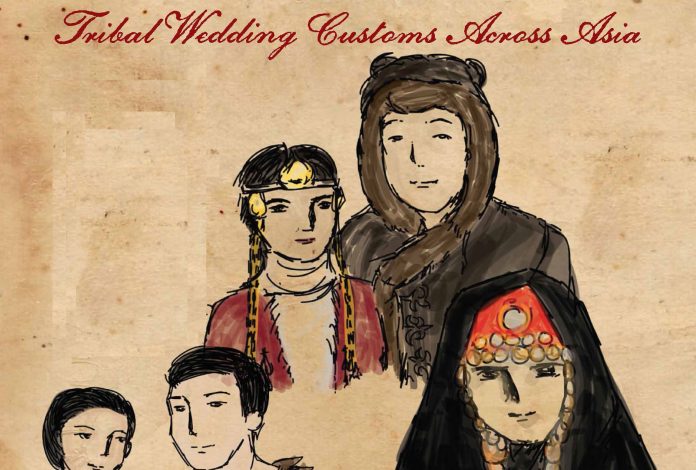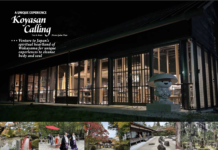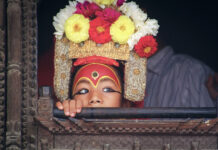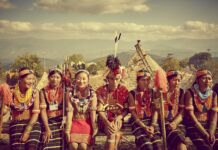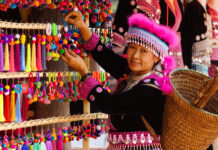Text by Simon Koh, Joan Koh, Selina Tan Illustration by Richard Cagomoc
Mention weddings and what comes to mind is the father of the bride walking his daughter down the aisle with the groom and bride eventually being married by a priest. But what are weddings and marriage rites like for different traditional tribes all across Asia? Is it just a variation of a tea ceremony between two families or are there elaborate rituals at play? Read on as we bring you a varied selection of some of the tribal wedding customs all across Asia:
NORTH ASIA
Eastern Siberia
Yakut

The parents of the bride assemble their relatives and take her to the groom’s house. The arrival of the male and female matchmakers is called the tiungnur hodohoi tiuser. Horses adorned with decorated saddles fetch the bride’s dowry and the cattle are brought. The men ride away first, and the horse carrying the bride is led by one of the people from her bridal party. Upon arriving at the groom’s house, she sends three men with the greatest capacity for alcohol to drink liquor in large quantities. Only after they have finished can the bride enter.
WEST ASIA
Negev Desert, Southern Israel
Bedouin

Wedding preparations begin with the bride’s friends decorating her limbs using colourful laylat al henna.
Guests can expect songs, dances and music played on a one-string rababa violin and dalouka, meaning “big drums”. The wedding ends with Tawaah, where the bride departs from the groom’s house, perched atop a camel fitted with a houdach, a special saddle.
One week after the official ceremony, the bride pays a visit to her parents and presents them with a sheep, rice, sugar and butter to indicate that she is living comfortably in a household of abundance.
OCEANIA
New Zealand
Maori

The Maori priest formally brings the ceremony to a start by commencing with the wedding ceremony and vows. This procedure is known as Te Manaakitanga. After this, the couple will be serenaded with the famous Maori love song Pokarekare ana before carrying out the blessings for the couple – Te Manaakiyanga. The finale is marked by the taonga (gift) presentation, symbolising new beginnings and happiness for the newlyweds. As the bridal party departs, they are again sent off with traditional Maori song and dance.
NORTH AFRICA, SAUDI ARABIA
Berber

On the third day of the wedding the new couple consummates their union either alone or with other newly married couples in a communal wedding chamber. In this community of other young couples, they learn to make love and get more accustomed to each other. They usually stay in this environment for five days. On the last night, all the newlyweds are presented to everyone in the village.
SOUTHEAST ASIA
Thailand
Akha

As the bride ascends the steps leading to the groom’s house, an elder beats the roof above her three times with a bamboo pole while calling out “Cho! Cho! Cho!”. The bride then drops the hair clip she keeps in her jacket, symbolising the severing of relationships with her clan. The couple sits on low stools while an egg is boiled for them. Under the instruction of the ritual director, the egg is passed back and forth three times before he feeds it to them. A small chicken is cooked next, and after eating it, the couple is considered joined as man and wife.
IRAN, MIDDLE EAST
Kurd

Elderly relations of the man visit the bride’s home before the actual ceremony and ask for some water, which is served by the girl, giving them a chance to judge her stature, character and appearance. Should they be impressed, they organise a second visit for wedding preparations to begin.
Different types of music performance using storytelling and poetry techniques are showcased by traditional musicians, and this begins one day before the actual event.
SOUTHEAST ASIA
Thailand
Hmong

The courting period generally occurs during the New Year festival, when young people, dressed in their best, gather in the vicinity of the village to play catch with black cloth balls made by the women. With women and men forming separate lines, each woman throws a ball to the man of her choice. If he is interested, he simply catches the ball.
Wedding festivities begin at the groom’s house, and his family must prepare two pigs, two to four chickens and 10 bottles of Hmong liquor. A chicken is sacrificed and placed on
a table where the go-betweens (the matchmakers) are honoured.
West Sumatra, Indonesia
Minangkabau

The bride’s family invites the groom to her house, where he is treated as an honoured guest. However, it is also during this welcome ceremony where a “battle of honour”, manifested in salutary words, between the two families takes place.
The husband continues to stay in his wife’s house and is expected not only to love her but also to respect the other members of the family.
Thailand
Karen

Courting is mainly done at funerals, when work in the villages ceases. Karen from neighbouring villages join in as well. The unmarried dress in their Sunday best and gather together to sing.
A special wedding dish is prepared by cooking a hen and a rooster together, adding a little spice at the end to represent their desire for a union free of conflict. The bride mixes the chicken meat with rice and they take turns to feed each other before the villagers join in.
Peninsular Malaysia
Orang Asli

The ceremony starts with the sharpening of teeth for both bride and groom in the belief that it will help get rid of previous misfortunes and mould the couple into more mature individuals. They are then required to perform the Berinai ceremony, where their hands are covered in henna leaves until morning.
The bride lives in the groom’s house for a few days before moving to the bride’s home for another few days. This is so that the newlyweds can get acquainted with their new families soon after marriage.
EAST ASIA
Taiwan
Rukai

On the day before the wedding ceremony, there is a pre-marriage rehearsal conducted in the main village square. Women wearing the traditional Rukai clothing consisting of elaborate beaded costumes and headdresses adorned with feathers prepare for the wedding feast the next day.
The bride emerges in the attire she put on the day before and the groom wears tight brocade leggings and a bright tunic. The long ceremony involves a parade of dowries such as pottery, cloth and hunted boar.
Taiwan
Amis

As soon as both sides agree to the arrangement, the girl chooses a date to start the pre-marriage ritual. She proceeds to serve at the groom’s home for about a month.
On the actual day, the groom and his friends carry his suitcases to the bride’s home and his friends announce, “The groom is married into the bride’s family today!” His maternal uncle continues by saying, “You are married into a new family today and you need to work hard, respect your uncles, be filial to your parents-in-law and not become lazy.” The groom then begins a new life in a matrilineal environment.
Read the rest of this article in No. 89 Issue 4/2012 of Asian Geographic magazine by subscribing here or check out all of our publications here.


